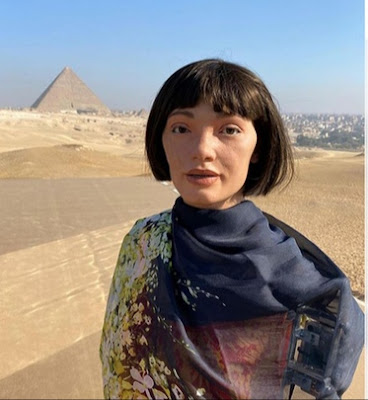The event of Ay-Da, who was arrested at customs, has aroused fresh concerns for society.
The robot artist Ay-Da, who arrived in Egypt with her inventor Edain Meller to participate in the Forever Is Now contemporary art biennial, was denied entry for 10 days by Egyptian customs. Espionage was suspected of Ay-Da. The robot and her sculpture were only allowed to enter Egypt and attend the show on the Giza plateau following the intervention of the British ambassador.
This customs incident provided an opportunity to discuss not just the world's first robot artist with a human face, but also the legal system that may be applied to androids.
This brunette with a mechanical hand is the world's first AI robot artist and a work of art in her own right. Ay-Da was "born" in the United Kingdom two years ago. Ada Lovelace, the first female coder, inspired her name. Edain Meller, a gallery owner and designer, is credited with creating Ay-Da, however the robot was designed by a vast team of engineers, programmers, psychiatrists, and art critics.
Meller is the one who came up with the concept for creating an android artist. He also worked on the appearance of Ay-da, and he had previous expertise with robot imagery from the series "Wild West." Ay-distinguishing Da's feature is that it can paint pictures from live owing to a microchip embedded in its eyes. He was the one that perplexed Egyptian customs authorities, who requested that Meller take the modem out of the robot's body and the camera out of its eyes. The British envoy to Egypt was able to liberate an unusual participant in the Biennale of Contemporary Art after 10 days of talks.
As a consequence, the Ay-Da sculpture was exhibited at the Egyptian Biennale of Contemporary Art, which was staged for the first time on the Giza plateau. This ancient landmark, which is protected by UNESCO, has never before held an exhibition. "The Sphinx's Riddle" is housed in a room next to a café. This is a massive sculpture (measured 2 x 2.5 meters) depicting a sleeping robot lady with the same hairdo, mechanical arms (albeit not identical to the prototype), and three legs as Ay-Da.
The work's concept is based on the Sphinx's riddle from Sophocles' tragedy "Oedipus the King": "Who walks on four legs in the morning, two in the afternoon, and three in the evening?" Only now does a sculpture of a robot-artist provide a response that differs from the traditional one. At the start, Meller spoke for him instead of his ward, saying, "We can conduct gene editing now, life extension is becoming quite possible." That is, in light of modern technology, the notion of perpetual life, which people have been thinking about since ancient times (and the fabrication of mummies is one of these forms), finds a new answer.
Progress allows for the extension of life and the creation of immortal creatures like Ay-Da. The robot artist, however, Alexander Ponomarev, a Russian participant in the Egyptian Biennale who displayed the gigantic piece "Ouroboros" here, was not pleased. He is confident that robots will not be able to compete with humans in terms of inventiveness in the future. Nonetheless, advancement will not halt until robots are perfected, and who knows how self-sufficient they will become in the future? They won't be able to produce, but they will be able to do a variety of technical and social jobs. The robot-artist, who showed the enormous installation "Ouroboros" here, was not pleased.
He is confident that robots will not be able to compete with humans in terms of inventiveness in the future. Nonetheless, advancement will not halt until robots are perfected, and who knows how self-sufficient they will become in the future? They won't be able to produce, but they will be able to do a variety of technical and social jobs.
Ay-da is the first robot artist, but it is far from the only android with a unique skill set. So, in Japan, there is a robot TV presenter created in the appearance and likeness of transgender performer Matsuko Deluxe, a popular TV personality. The presenter and his copy made their debut appearance together on the evening show in 2015. The Land of the Rising Sun is a pioneer in robotics, with a large number of humanoid robots in various enterprises and research organizations. There's even a robot professor that looks like Henrik Scharf, a Danish lecturer from Aalborg University.
Other countries, on the other hand, are not far behind. So, in 2015, Nadine, a companion robot with whom you may converse on any subject, was unveiled in Singapore. She is employed as a receptionist at Nanyang Technological University, where she was born. Scientists believe that in the future, such robots will be able to serve as personal assistants, nannies, psychiatrists, and instructors in homes and companies.
And the incident with Ay-Da at Egyptian customs sparked an intriguing question: isn't it past time for robots to develop their own set of rules and specify some guidelines for travel? It's unclear what espionage intentions Ay-Da would be pursuing in this situation. However, the possibility of utilizing a robot as a spy exists in theory.
Experts also began discussing other legal challenges, such as new technology' interference with privacy. It appears that it is time for countries' legislators to begin reacting to technological innovation.

